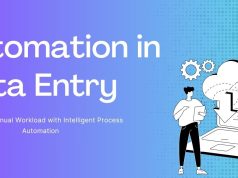In today’s digital scenario, companies produce outstanding data volumes through countless touch points. From customer interaction and sales transactions to operational matrix and market research, this continuous flow of information has tremendous potential value. However, raw data provides limited tools alone. The real power emerges through effective data processing – significant changes that convert raw information into action -based business intelligence.
Since organizations recognize fast data as their most valuable assets, it has become a competitive requirement to understand that this resource treats and benefits properly. This broad guide detects the basic importance of data processing and many benefits in each aspect of modern business operations.
What Exactly is Data Processing?
Data processing encompasses the systematic collection, manipulation, and transformation of raw data into meaningful information. It represents the bridge between chaotic, unstructured data points and organized, actionable insights that drive informed decision-making.
The data processing lifecycle typically follows these key stages:
- Collection: Gathering raw data from various sources
- Preparation: Cleaning, organizing, and formatting data for analysis
- Input: Entering the prepared data into the processing system
- Processing: Applying algorithms, calculations, and transformations
- Output: Generating processed results in usable formats
- Storage: Archiving processed data securely for future reference
- Interpretation: Analyzing outputs to extract meaningful insights
When executed properly, this systematic approach ensures that organizations derive maximum value from their data assets while maintaining data integrity throughout the process.
The Critical Benefits of Effective Data Processing
1. Enhanced Decision-Making Capabilities
In the modern business environment, gut feelings and intuition are no longer sufficient for making strategic decisions. Data processing transforms scattered information into comprehensive insights that empower leaders to make decisions based on evidence rather than assumptions.
When organizations process data effectively, they can:
- Identify emerging trends before competitors
- Predict future outcomes with greater accuracy
- Understand complex cause-and-effect relationships
- Quantify the potential impact of different scenarios
- Allocate resources more strategically
According to a recent study by McKinsey & Company, organizations that leverage data-driven decision-making are 23% more likely to outperform competitors in terms of profitability and 19% more likely to achieve above-average productivity growth.
2. Operational Efficiency and Cost Reduction
Efficient data processing reveals opportunities for operational improvements that might otherwise remain invisible. By analyzing patterns in operational data, organizations can identify:
- Bottlenecks in workflows and production processes
- Underutilized resources and assets
- Opportunities for automation and optimization
- Inefficient spending patterns
- Redundant activities consuming valuable resources
For example, manufacturing companies implementing advanced data processing systems have reported average efficiency improvements of 15-20% and cost reductions of 10-15% through optimized production scheduling and reduced downtime.
3. Enhanced Customer Experience and Personalization
Modern consumers expect personalized experiences tailored to their specific preferences and behaviors. Proper data processing enables organizations to develop deep customer insights that drive meaningful personalization:
- Individual purchase histories and browsing behaviors
- Communication preferences and response patterns
- Product affinity and propensity models
- Customer lifetime value projections
- Churn risk indicators and loyalty predictors
These insights allow businesses to deliver hyper-relevant experiences that strengthen customer relationships. According to Accenture research, 91% of consumers are more likely to shop with brands that recognize, remember, and provide relevant offers and recommendations.
4. Improved Risk Management and Compliance
In highly regulated industries, data processing plays a crucial role in managing risk and ensuring compliance with evolving regulatory requirements. Effective processing systems help organizations:
- Detect potential fraud patterns and security breaches
- Monitor compliance with industry regulations
- Identify financial irregularities and audit concerns
- Assess and quantify various business risks
- Document compliance efforts for regulatory review
Financial institutions utilizing advanced data processing for fraud detection report up to 60% improvement in identifying suspicious activities before they impact customers or operations.
5. Accelerated Innovation and Product Development
Data processing provides the foundation for innovation by helping organizations understand market gaps, customer needs, and emerging opportunities. This translates to:
- Faster identification of viable product opportunities
- More accurate prioritization of development efforts
- Reduced time-to-market for new offerings
- Lower failure rates for product launches
- Continuous improvement through feedback analysis
At Data Entry we’ve observed that companies leveraging advanced data processing techniques typically reduce their product development cycles by 30-40% while simultaneously increasing launch success rates.
6. Competitive Market Intelligence
Understanding the competitive landscape is essential for strategic positioning. Data processing transforms scattered market information into cohesive intelligence about:
- Competitor pricing strategies and promotions
- Market share fluctuations and trends
- Consumer sentiment and brand perception
- Emerging market entrants and potential disruptors
- Effectiveness of various marketing channels
This intelligence enables organizations to respond more effectively to competitive threats and capitalize on emerging opportunities before others can act.
Modern Approaches to Data Processing
As data volumes continue to expand exponentially, traditional processing methods are giving way to more sophisticated approaches:
Real-Time Processing
Unlike batch processing, which handles data in large chunks at scheduled intervals, real-time processing analyzes data continuously as it arrives. This approach enables:
- Immediate response to emerging situations
- Time-sensitive decision-making
- Continuous monitoring of critical metrics
- Dynamic adjustment of automated systems
For industries like financial services, telecommunications, and e-commerce, real-time processing has become essential for delivering competitive customer experiences and managing operational risks.
Cloud-Based Processing
Cloud platforms have revolutionized data processing by providing:
- Virtually unlimited scalability
- Reduced infrastructure costs
- Enhanced accessibility and collaboration
- Advanced processing capabilities without specialized hardware
- Improved disaster recovery and business continuity
Organizations transitioning from on-premises to cloud-based processing typically report efficiency improvements of 20-30% and cost reductions of 25-40%.
AI and Machine Learning Integration
The integration of artificial intelligence and machine learning into data processing workflows has transformed what’s possible:
- Predictive analytics that forecast future outcomes
- Natural language processing for unstructured text analysis
- Image and video processing for visual data extraction
- Anomaly detection for identifying unusual patterns
- Automated decision-making for routine processes
According to research from MIT, organizations implementing AI-driven data processing experience productivity improvements averaging 35% across affected business processes.
Overcoming Data Processing Challenges
While the benefits are compelling, organizations must address several challenges to maximize their data processing effectiveness:
Data Quality Concerns
Poor data quality remains one of the biggest obstacles to effective processing. Organizations must implement:
- Comprehensive data governance frameworks
- Automated validation and verification procedures
- Clear data ownership and accountability
- Regular data cleansing and enrichment processes
Industry estimates suggest that poor data quality costs organizations an average of 15-25% of their revenue due to missed opportunities and flawed decision-making.
Privacy and Security Considerations
As data processing capabilities advance, so do privacy concerns and security threats. Effective strategies include:
- Privacy-by-design methodologies in processing workflows
- Granular access control and authorization protocols
- Regular security audits and vulnerability assessments
- Transparent data usage policies and consent management
- Compliance with evolving regulations like GDPR and CCPA
Talent and Expertise Gaps
The rapidly evolving nature of data processing technologies has created significant skills gaps. Organizations can address these through:
- Continuous learning programs for existing staff
- Strategic hiring of specialized data professionals
- Partnerships with external data processing experts
- Investment in intuitive tools that reduce technical barriers
- Creating centers of excellence to disseminate best practices
Implementing Effective Data Processing: A Strategic Approach
For organizations looking to enhance their data processing capabilities, a strategic, phased approach typically yields the best results:
Phase 1: Assessment and Planning
- Audit existing data assets and processing capabilities
- Identify high-priority use cases and quick wins
- Develop clear objectives and success metrics
- Create a roadmap for capability development
- Secure executive sponsorship and resource commitments
Phase 2: Foundation Building
- Establish data governance frameworks and policies
- Implement data quality management procedures
- Develop the necessary technical infrastructure
- Build core data processing capabilities
- Train key personnel on new systems and approaches
Phase 3: Scaling and Integration
- Expand processing capabilities across the organization
- Integrate data silos for comprehensive analysis
- Automate routine processing workflows
- Implement advanced analytics capabilities
- Develop self-service tools for business users
Phase 4: Continuous Improvement
- Monitor processing performance and outcomes
- Refine approaches based on emerging needs
- Stay current with evolving technologies
- Expand use cases as capabilities mature
- Foster a data-driven culture throughout the organization
Data Processing as a Strategic Imperative
In today’s computer -rich business environment, effective treatment has infected from a technical function to a strategic imperative. Organizations that stand out in converting raw data into action worthy intelligence struggles with important abilities.
The benefits of strong data processing are spread beyond operating capacity – they originally change how organizations understand their customers, adapt operations, control risks and identify new opportunities. Since data volumes are growing rapidly, the competitive advantage with better processing capacity will only increase.
Forward -holding organizations believe that the skill of data processing is not only a technical challenge, but a commercial discipline that requires ongoing investments, performing commitment and cultural change. Those who create this commitment to continuous success in a fast computer -driven world.
By developing extensive strategies that address both technical and organizational dimensions of data processing, companies can unlock the entire potential of their most valuable assets – their data – and benefit from operating the outstanding levels of performance and innovation.










